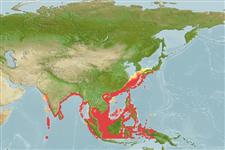Common names from other countries
>
Scombriformes (Mackerels) >
Scombridae (Mackerels, tunas, bonitos) > Scombrinae
Etymology: Scomberomorus: Latin, scomber = mackerel + Greek, moros = silly, stupid (Ref. 45335).
Environment: milieu / climate zone / depth range / distribution range
экология
морской; мигрирует в океане (Ref. 51243). Tropical; 39°N - 6°S, 70°E - 138°E (Ref. 168)
Indo-West Pacific: west coast of India and Sri Lanka along the continental shelf eastward to Sumatra, Indonesia and Singapore, and northward to China, Korea (Ref. 9684) and Wakasa Bay, Sea of Japan. Does not extend past Sumatra in the East Indies (Ref. 9684).
Length at first maturity / Size / Вес / Возраст
Maturity: Lm ?, range 75 - ? cm
Max length : 150 cm FL самец/пол неопределен; (Ref. 168); common length : 60.0 cm FL самец/пол неопределен; (Ref. 168); наибольший вес (опубликованные данные): 15.0 kg (Ref. 168)
колючие лучи спинного плавника (общее число) : 14 - 17; членистые (мягкие) лучи спинного плавника (общее число) : 20 - 24; колючие лучи анального плавника: 0; членистые (мягкие) лучи анального плавника: 20 - 24; позвонки: 46 - 47. Interpelvic process small and bifid. Lateral line with many auxiliary branches extending dorsally and ventrally in anterior third, gradually curving down toward caudal peduncle. Intestine with 4 folds and 5 limbs. Swim bladder absent. Body covered with small scales. Sides silvery with spots scattered along lateral median line.
Feeds on small schooling fishes, such as sardines and anchovies and on shrimps. This species makes up an important part of the drift net fishery in Palk Bay and the Gulf of Mannar. Marketed fresh and dried-salted (Ref. 9684).
Life cycle and mating behavior
Maturities | размножение | Spawnings | Egg(s) | Fecundities | личинки
Collette, B.B. and C.E. Nauen, 1983. FAO Species Catalogue. Vol. 2. Scombrids of the world. An annotated and illustrated catalogue of tunas, mackerels, bonitos and related species known to date. Rome: FAO. FAO Fish. Synop. 125(2):137 p. (Ref. 168)
Статус Красного Списка МСОП (Ref. 130435)
CITES (Ref. 128078)
Not Evaluated
Угроза для людей
Harmless
Использование человеком
рыболовство: не имеет хозяйственного значения; объект спортивного рыболовства: да
дополнительная информация
инструменты
Специальные отчеты
Скачать в формате XML
ресурсы в Интернет
Estimates based on models
Preferred temperature (Ref.
115969): 20.1 - 28.6, mean 27.3 (based on 823 cells).
Phylogenetic diversity index (Ref.
82804): PD
50 = 0.5000 [Uniqueness, from 0.5 = low to 2.0 = high].
Bayesian length-weight: a=0.00832 (0.00383 - 0.01808), b=3.03 (2.86 - 3.20), in cm Total Length, based on LWR estimates for this Genus-body shape (Ref.
93245).
Trophic level (Ref.
69278): 4.2 ±0.74 se; based on food items.
устойчивость к внешним воздействиям (Ref.
120179): средний (среднего размера), минимальное время удвоения популяции 1.4-4.4 года (Preliminary K or Fecundity.).
Fishing Vulnerability (Ref.
59153): Very high vulnerability (90 of 100).
